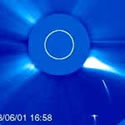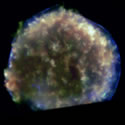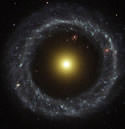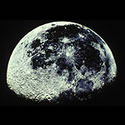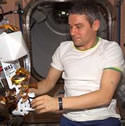
Image credit: NASA
Expedition Five Commander Valery Korzun and Flight Engineer Peggy Whitson spent more than 4 hours in space on Friday, working on improvements to the International Space Station. During this first of two spacewalks scheduled for Expedition Five, the astronauts installed six debris shields to the outside of the Zvezda module – these are designed to stop micrometeorites from damaging the station and crew. Seventeen more shields will be installed in future missions.
Expedition Five Commander Valery Korzun and Flight Engineer Peggy Whitson stepped outside the Pirs Docking Compartment of the International Space Station today and installed debris shields on the Russian Zvezda Service Module in a 4 hour, 25 minute spacewalk.
It was the first of two spacewalks for the Expedition Five crew, the third of Korzun?s career and the first for Whitson. Today?s excursion was the 42nd spacewalk in support of ISS assembly and maintenance and the 17th staged from the station itself. 25 spacewalks at the ISS have originated from visiting space shuttles. While Korzun and Whitson worked outside, Flight Engineer Sergei Treschev tended to station systems and choreographed the spacewalk from inside Zvezda.
After a 1 hour, 43 minute delay to the start of the spacewalk because of a misconfigured valve regulating the operation of the primary oxygen bottles in their Orlan spacesuits, Korzun and Whitson opened the hatch to Pirs at 4:23 a.m. Central time (923 GMT) as the ISS flew over the southern Atlantic Ocean east of the southern coast of South America at an altitude of 230 statute miles. Their first task was to set up tools and unfurl a telescoping crane called the Strela boom from the side of the docking module that is attached to the nadir port of Zvezda.
They pressed ahead to move six micrometeoroid debris shields from a temporary stowage location on the connecting module adapter between the U.S. and Russian segments of the ISS that were delivered in June during the STS-111 mission of the shuttle Endeavour.
One by one, the shields were affixed around Zvezda, designed to provide debris protection for the lifetime of the module. 17 additional shields will be flown to the ISS on future missions to complete the job.
Because of the late start to the spacewalk, Russian flight controllers decided to defer the refurbishment of an experiment on Zvezda called Kromka, designed to collect samples of residue emitted from the module?s jet thrusters. That lower priority task and the swabbing of thruster residue from Zvezda?s hull for analysis will be conducted on a future spacewalk. It was not immediately known whether Korzun and Treschev would perform those tasks next Friday during the second spacewalk of the Expedition.
After retrieving their tools and stowing the Strela crane, Korzun and Whitson returned to Pirs and closed the hatch at 8:48 a.m. Central time (1348 GMT) to wrap up their excursion.
Korzun will venture outside Pirs one week from today with Treschev to install equipment on the exterior of the Russian module which will facilitate the placement of future payloads and the routing of spacewalkers? tethers and to replace Japanese experiments outside Zvezda which measure the effect of atomic oxygen in low Earth orbit on sample materials. Korzun and Treschev will also install two additional amateur radio antennas outside Zvezda to improve contacts with ham radio operators on Earth.
Information on the crew’s activities aboard the space station, future launch dates, as well as station sighting opportunities from anywhere on the Earth, is available on the Internet at:
http://spaceflight.nasa.gov
Details on station science operations can be found on an Internet site administered by the Payload Operations Center at NASA’s Marshall Space Flight Center in Huntsville, Ala., at:
http://www.scipoc.msfc.nasa.gov
The next ISS status report will be issued on Friday, Aug. 23, after the next station spacewalk, or sooner, if events warrant.
Original Source: NASA News Release

